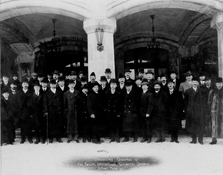Prehistoric Toronto
Coleman’s research into the Pleistocene of the Toronto Region was largely focused on two areas: the ravines and brickyards of the Don Valley, and the shore of Lake Ontario in the east end of the city, notably the Scarborough Bluffs and the "Dutch Church" bluff. (See Coleman’s geological map of "Toronto and the Vicinity", 1913.)
Coleman found in the Don Valley Brickyards a complete succession of glacial and interglacial beds. Toronto’s economy had thrived in the 1880s, brick houses were constructed in suburbs surrounding the city core. The Toronto Beltline Railway was constructed for commuters. These developments involved excavations that exposed geologic layers of local hillsides.
The Toronto formation was found to consist of a series of three ice sheets moving through the region. As each sheet retreated, it left behind a layer of glacial deposits known as "till".
The first ice sheet to pass through was part of the Illinoian glaciation (circa 135, 000 years ago). It left behind a lake 60 feet higher than the present Lake Ontario. On top of its (York) till was the ‘Don Formation’ of stratified sand and clay (circa 125, 000 – 80, 000 years ago). Coleman found a number of fossils in the Don bed which demonstrated that Toronto had experienced a period of mild climate with temperatures similar to those of present day Pennsylvania. The fossils uncovered by Coleman and the brick yard’s workmen included wooden logs, pollen and leaves from a variety of trees, clams (unios) and animal teeth.


































